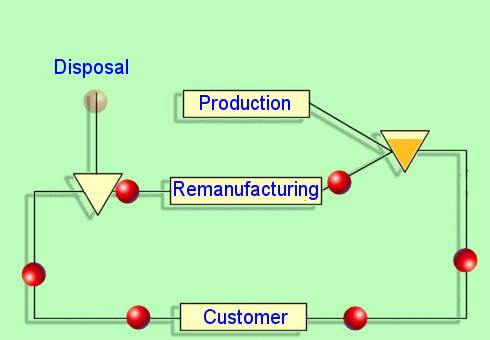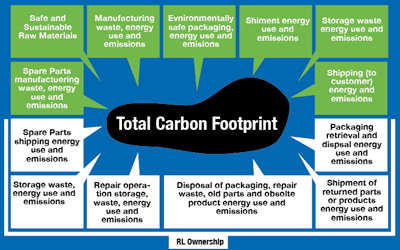 Once you determine which products pose the greatest asset value in terms of recoverability, you should then look for potential ways to reprocess or reuse waste byproducts or other manufacturers that may be turn your waste into their product feedstock. Your company, your customers and the environment will benefit tremendously.
Once you determine which products pose the greatest asset value in terms of recoverability, you should then look for potential ways to reprocess or reuse waste byproducts or other manufacturers that may be turn your waste into their product feedstock. Your company, your customers and the environment will benefit tremendously.
by Dave Meyer, Sustainable Economic and Environmental Development Solutions (SEEDS) Global Alliance (Northwest Operations) and SVP of Greenbridge International, LLC. Follow Dave on Twitter @DRMeyer1 and LinkedIn.
In Part 1 on this series, I presented some definitions of reverse logistics from a traditional versus sustainability focused mindset, and extended product responsibility.
Reverse logistics includes processing returned merchandise due to damage, seasonal inventory, restock, salvage, recalls, and excess inventory. It also includes recycling programs, hazardous material programs, obsolete equipment disposition, and asset recovery. While product “take-back programs” have been a part of many companies operational playbook for some time, more sophisticated approaches are emerging which involve greater degrees of coordination and planning among multiple suppliers.
For a logistics practitioner, the best value choice for disposition is still often determined by the most profitable alternative:
- Reconditioning – when a product is cleaned and repaired to return it to a “like new” state
- Refurbishing – similar to reconditioning, except with perhaps more work involved in repairing the product.
- Remanufacturing – similar to refurbishing, but requiring more extensive work; often requires completely disassembling the product
- Resell – when a returned product may be sold again as new
- Recycle – when a product is reduced to its basic elements, which are reused – also referred to as asset recovery.
Product take-back programs
 Product take-back programs are particularly popular in the retail sector, as manufacturers reap the benefits for material recovery while customers find convenient ways to jettison used products for recycling (printer cartridges, used computers, aluminum cans, tires, batteries, etc). As my first post mentioned, restricted materials directives in Europe such as WEEE and RoHS have for years been dictating how manufacturers manage “end of life” equipment issues. In his book aptly named “The Truth about Green Business”, Gil Friend describes a series of steps that retailer Patagonia and manufacturer Hewlett Packard (HP) have taken to close the loop on product manufacturing to mutual benefit. In particular, to meet the growing demand to manage end of life issues for computers and other electronics, HP and mining company Noranda crafted a take back system in the early 2000’s that is unique. The system covers pickup, transportation, evaluation for reuse or donation, and recycling for products ranging from printers to scanners. Noranda provides HP and other OEMs with disassembly, product testing and metal recovery services. Part of this process involved installing efficient warehousing systems that electronically tracked materials through the recycling process. About 3.5 million pounds of materials are processed annually. Dell Computer Corporation also has a similar take-back program, aimed at its leasing customers and other large companies that may have Dell units. Dell Financial Services handles the asset recovery for customers and the viability of the units determines how they are recycled/
Product take-back programs are particularly popular in the retail sector, as manufacturers reap the benefits for material recovery while customers find convenient ways to jettison used products for recycling (printer cartridges, used computers, aluminum cans, tires, batteries, etc). As my first post mentioned, restricted materials directives in Europe such as WEEE and RoHS have for years been dictating how manufacturers manage “end of life” equipment issues. In his book aptly named “The Truth about Green Business”, Gil Friend describes a series of steps that retailer Patagonia and manufacturer Hewlett Packard (HP) have taken to close the loop on product manufacturing to mutual benefit. In particular, to meet the growing demand to manage end of life issues for computers and other electronics, HP and mining company Noranda crafted a take back system in the early 2000’s that is unique. The system covers pickup, transportation, evaluation for reuse or donation, and recycling for products ranging from printers to scanners. Noranda provides HP and other OEMs with disassembly, product testing and metal recovery services. Part of this process involved installing efficient warehousing systems that electronically tracked materials through the recycling process. About 3.5 million pounds of materials are processed annually. Dell Computer Corporation also has a similar take-back program, aimed at its leasing customers and other large companies that may have Dell units. Dell Financial Services handles the asset recovery for customers and the viability of the units determines how they are recycled/
Turning Trash to Into New Products
In a recent post by author Marc Gunther, Walmart announced that as part of its efforts to reduce its waste streams from its retail and distribution centers, they are working with one if its suppliers (Worldwise) to begin what it calls the Full Circle program. This program creates a closed-loop system that takes old plastic bottles, clothes hangers, plastic bags and corrugated cardboard and makes new products from materials that would otherwise be waste- and turns them into eco friendly pet products that are in turn resold in Walmart stores. And there you have it-trash to treasure through “upcycling”.
Quoting Gunthers post, “We’re committed to creating zero waste,” explains John Kunkel, senior buyer, pets for Walmart. One way to get there is to take things that Walmart throws away and instead of sending them to a landfill, make them into something useful.” The effort reportedly took more than a year and was coordinated with “seven or eight different divisions of the company.” according to Mr. Kunkel. After Walmart’s waste is baled, it is separated into its components at materials recycling facilities. Then the baled waste is trucked to supplier Worldwise’s North American manufacturing plants. The products that result are then shipped to distribution centers and to all of Walmart’s U.S. stores. “We’ve had to create a playbook,” Kunkel said. “Now other manufacturers can implement a closed loop in their business.”
Getting Started
Reverse logistics deals with five basic questions:
- What alternatives are available to recover products, product parts, and materials?
- Who should perform the various recovery activities?
- How should the various activities be performed?
- Is it possible to integrate the activities that are typical for reverse logistics with classical production and distribution systems?
- What are the costs and benefits of reverse logistics, both from an economical as an environmental point of view?
To first address these questions, ask yourselves which products are suitable for reverse logistics? Base your decisions on “recoverable” characteristics that a product might have such as:
- The product size
- Volume of sale of products
- Hazardous components
- Design cycle and product life cycle
- Product traceability
- Product modularity
As an example, the graphic below presents a conceptual supply chain “total carbon footprint” and the various touchpoints from a manufacturing and reverse logistics perspective (graphic via Reverse Logistics – Turning Green to Gold, Reverse Logistics Magazine, Aug/Sept 2008).
 Once you can get a handle around which products pose the greatest asset value in terms of recoverability, the next phase is in looking for potential ways to reprocess or reuse waste byproducts or other manufacturers that may be turn your waste into their product feedstock. Either way it’s a win-win-win- for your company, your customers and the environment.
Once you can get a handle around which products pose the greatest asset value in terms of recoverability, the next phase is in looking for potential ways to reprocess or reuse waste byproducts or other manufacturers that may be turn your waste into their product feedstock. Either way it’s a win-win-win- for your company, your customers and the environment.
Further posts will focus on proactive steps that companies can take to design sustainability in product manufacturing, and ways to coordinate reverse logistics campaigns with suppliers and customers.
Meantime, it would be valuable to this readership if you’d consider sharing what your company is doing to “lighten the environmental load” on the planet and in your manufacturing process.



















